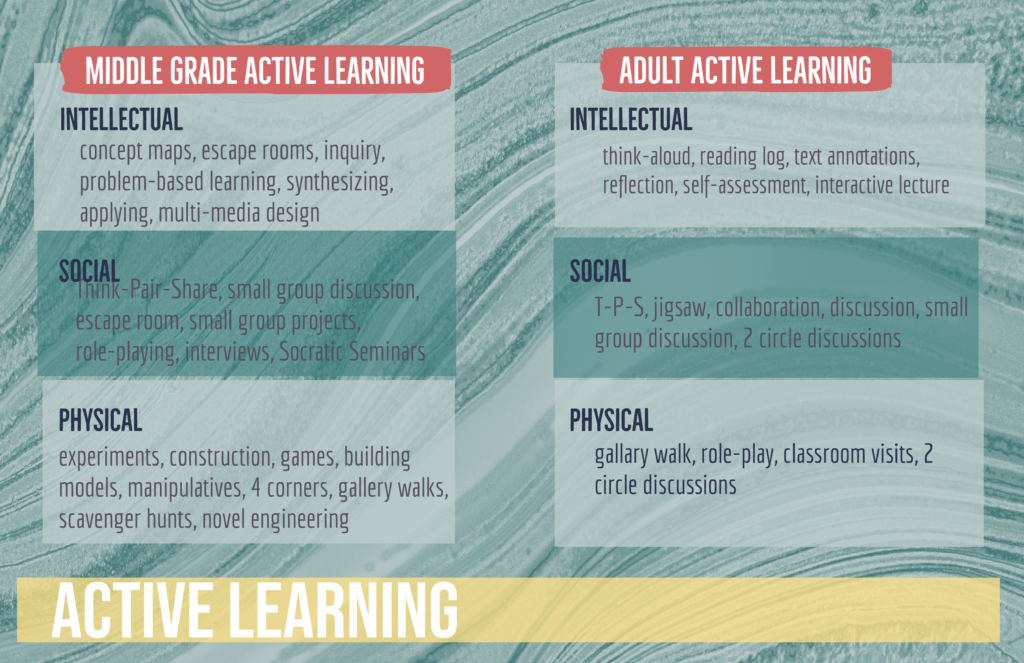When I taught at a middle/high school, the 12th grade social studies teacher, who also used active learning strategies, asked to swap classes for a day so that he could experience middle school active learning. I assumed teaching 12th graders would be similar to teaching 7th graders, but with a bit more advanced vocabulary and a bit less make-believe.
I was wrong.
I realized early on that I was not quite getting it. I looked at a sea of bored faces, as I spoke with increasing animation. I had them to work in groups, attempted to get them moving, changed learning partners, and engaged them in active inquiry. The bored faces became amused then reset to bored. The quieter and sleepier they got, the more I ramped up my instruction to engage and energize them.
When the day ended, my friend and I met in the hallway, both exhausted, defeated, and with the same incredulous question: “How do you do it?” My friend was overwhelmed because the 7th graders never stopped moving/talking/wiggling, and I was overwhelmed because I couldn’t get the seniors to start doing literally anything.
That was the moment when we both realized that “active learning” meant something far different in his classroom than it did in mine.
For older learners, active learning is an effective tool for ensuring meaningful learning experiences result in information retention. For teachers of younger learners, active learning is both a survival skill (because middle schoolers lack the self control older learners have when bored, which results in dangerous or destructive behaviors) and a way in which teachers can tap into middle schoolers’ natural tendency toward nonstop activity t.
If the gap between middle school active learning and 12th grade active learning seemed tremendous, one can only imagine the chasm between that and active learning at professional development sessions for teachers. The principles of active learning are valuable, but require adapting when shifting them from younger learners to adults.
Researching this shift is hindered by the same problem my friend and I confronted: the phrase “active learning” can be defined in a myriad of ways, and often what one person defines as active learning would not be considered active anything to someone else. Unravelling those differences and translating youth active learning to adulthood is key to effectively using active learning with adults.
Active Learning Framework

In her 2015 article Active Learning in the Middle Grades, and her 2016 book of the same name, Susan Edwards introduces the Active Learning Framework, which compiles the three types of active learning and addresses the ways in which they interact (Edwards, 2015). The framework includes intellectual, physical and social active learning, and uses a Venn diagram to indicate how they overlap (Edwards, 2015). Socially active learning, such as partner discussions or group work align well with the middle school concept and meet middle schoolers’ developmental need for social interaction. Physically active learning such as manipulatives and hands-on projects allows middle schoolers to engage through movement and touch. Intellectually active learning activities function in opposition to the banking theory of education, in which students passively receive information, and taps into learning at the tip of Bloom’s taxonomy. Edwards emphasizes that active learning must be purposeful to be a successful component of lessons (Edwards, 2015). These three components and the necessity of purposeful activity inherent in middle school active learning best practices can be applied to adult active learning.
Adult Learning Theory
There are multiple elements of adult learning theory that can be met with active learning activities. Of the six elements of adult learning theory, three can be fully or partially met through the use of active learning activities: encourage active participation, employ immediate application, and empower through reflection and action. Dr. Joey Freeman lists several examples of adult learning theory in action that also meet the criteria for active learning: limiting modeling and direct teaching, “group problem solving, sharing of resources,” group work, and inquiry based learning (Freeman, 2022).
Some Adult Active Learning Best Practices
Active learning with adults differs in that the goal is entirely engagement for the sake of learning, whereas with younger students engagement for learning is the primary goal, but a secondary goal of decreasing problem behaviors also exists.
Multiple sources present educators/trainers with a myriad of best practices for using active learning when teaching adults. The Learning policy Institute identifies active learning as a way that teachers can immerse themselves in the same learning experiences that they provide their students (Darling-Hammond, 2017). Boston University provides three objectives that serve as best practices, they state that active learning should: help students meet objectives, allow for easy participation, and include feedback (Boston University, 2022). A resource on active learning from New York University suggests several activities as well as provides guidance such as explaining instructions clearly, and inserting active learning into otherwise lecture-based training content (NYU, 2022).

Resources
Boston University. (2022). Active Learning: Teaching Guide » Center for Teaching & Learning | Boston University. Boston University Center for Teaching and Learning. https://www.bu.edu/ctl/guides/active-learning/
Darling-Hammond, L., Hyler, M., & Gardner, M. (2017, May). Title LEARNING POLICY INSTITUTE | RESEARCH BRIEF 1 Effective Teacher Professional Development. Learning Policy Institute. https://files.eric.ed.gov/fulltext/ED606741.pdf
Edwards, S. (2015). Active Learning in the Middle Grades. Middle School Journal, 46(5), 26–32. https://doi.org/10.1080/00940771.2015.11461922, https://eric.ed.gov/?q=source%3a%22Middle+School+Journal%22&id=EJ1059827
New York University. (2022). Best Practices: Active Learning. NYU Faculty Knowledge Base. https://www.nyu.edu/faculty/teaching-and-learning-resources/strategies-for-teaching-with-tech/best-practices-active-learning.html
Freeman, J. (2022, February 8). How can the integration of adult learning theories enhance the design of educational technology professional development sessions? – Professor J. Freeman’s bPortfolio. Professor J Freeman. http://professorjfreeman.org/istestandardsforcoaching/how-can-the-integration-of-adult-learning-theories-enhance-the-design-of-educational-technology-professional-development-sessions/
University of Washington, Bothell. (2021). Best Practices for Active Learning – Information Technology. UW Bothell. https://www.uwb.edu/it/training-and-support/teaching-learning/active-learning/best-practices


